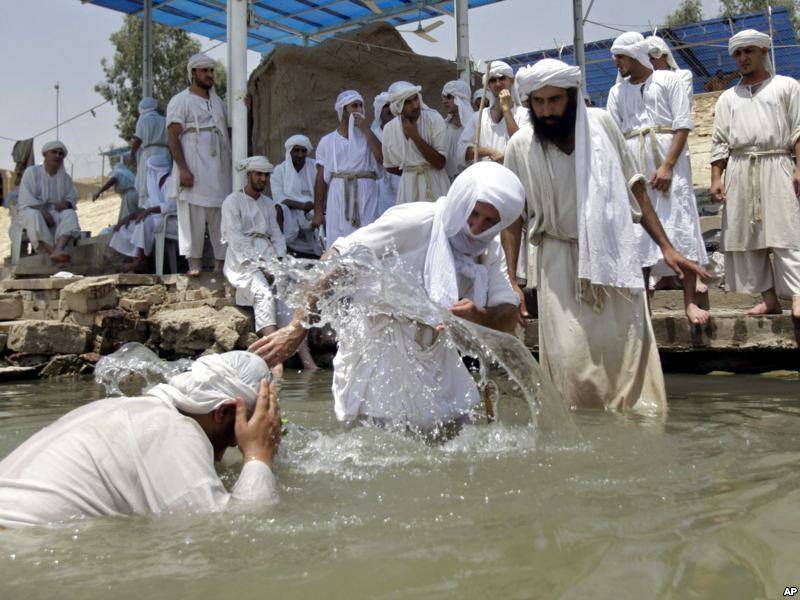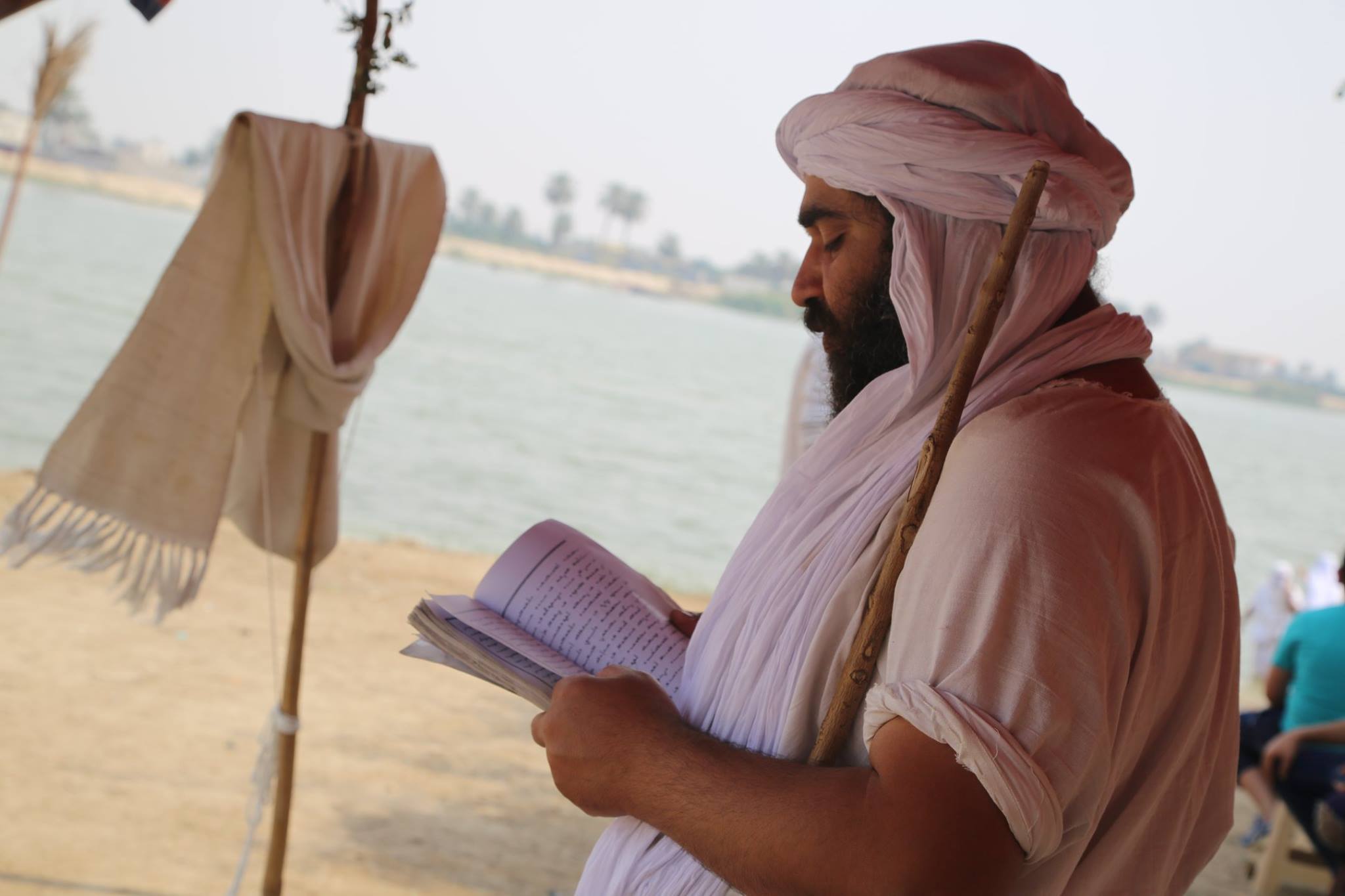Samar Khalid, 26, was shocked when she has heard some points that has nothing to do with the Sabean Mandean (Subbi) religion. “They know nothing about our religion, they don’t know what is Mandaeism or its rituals. They just follow what they hear on the streets,” Khalid sobbed.
“All what she said is no related to our religion, it is just a stereotypical image accumulated since years for absence of a media that covers religions and religious pluralism,” she added.
Sabean Mandaeism is the most ancient monotheist religion in the history of humanity, native to the plain of southern Mesopotamia and particularly south of Iraq in the province of Misan adjacent to the marshes where Mandeans held their baptism rituals.
Mandaeans were probably the first to practice baptism. They are a closed ethno-religious community, practicing Mandaeism, which is a monotheistic religion. The Mandaeans classify existence into two main categories: light and dark. They have a dualistic view of life, that encompasses both good and evil; all good is thought to have come from the World of Light and all evil from the World of Darkness.

Religious gathering of the Subbis, meaning Madean Sabean adherent in Iraqi. Photo by Sandrka Mandean Society.
Stereotype image to be updated
One of the challenges for the Mandeans in Iraq is the mistaken stereotypical image of the society for the Mandeas. “We are accused of worshipping stars and other planets or we choak animals to death then eat it and other nonsense,” said Nadia Mighamis, former director general for Mandean Endowment in Baghdad.
“These false concepts posed many members of Mandean sect to violence and persecution for years forcing them to translate their holly books into Arabic 25years ago o revela the truth and put an end to inhuman attitude and to prove monotheism in Mandaeism,” she adds.
“These false concepts posed many members of Mandean sect to violence and persecution for years,” she adds.
She believes one of the characteristics of Mandaeism is their deep commitment to their rituals from 2,000 years up to the present. “They have sticked to one ritual that has not changed and wont.”
The holly book of the Mandeans is called “Kanza Raba,” or the (Holly Treasure), which embraces first pages of Adam and his preaches in Eastern Aramaic. It is made of two parts: the first is about secular affairs and the second about post-death soul leaving the mortal body toward world of light.
Many Iraqi Mandaeans have fled the country in the face of this violence, and the Mandaean community in Iraq faces extinction. Out of the over 60,000 Mandaeans in Iraq in the early 1990s, fewer than 5,000 to 10,000 remain there as of 2007. In early 2007, more than 80% of Iraqi Mandaeans were refugees in Syria and Jordan as a result of the sectarian violence and terrorism. As of 2019, a study estimated the Iraqi Mandaean population to be 3,000, only.
“We have been under threats and purposeful killing but we are the residents of this land of Mesopotamia and will practice our rituals lasted since thousands of years,” said Osama Nabil, a 38-year-old Mandean.
“I feel my existence when we practice our prayers,” he adds.
“I feel my existence when we practice our prayers,” he adds.
Sabaeans are a lonely, peaceful and reclusive community. The only one way to become a Sabaean, is to be born to parents who both belong to the faith. It bans interreligious marriage. Sabaean Mandeans fast and pray three times a day to God in Aramaic, a language close to the one spoken by Jesus Christ. Sabaeans have no doubts their religion is older than Christianity, Judaism, or Islam.
Baptisms are a central theme in Mandaeism, believed to be necessary for the redemption of the soul.
Distorting the image of Mandaeism
Some make use of the misconceptions about Mandaesm for financial profits by promotion of magic and conjuration by publishing photos for Mandean clerics and rituals.
Senior Mandean clergy Satar Jabar Helo, the head priest and spiritual leader of the Sabaeans in Iraq, said in a statement in February 2020, that he is innocent and not aware of photos on social media for people claiming magic for special purposes.
He emphasized that some people used his photos in promotions for magic which is one of the grand taboos forbidden in Mandaeism. “Do not address liar magicians and fortunetellers in the darkness. Any one practice it, his fate is reviving fire,” he quoted Kanzaraba holly book, First part.
“Do not address liar magicians and fortunetellers in the darkness. Any one practice it, his fate is fire,” he quoted Kanzaraba holly book, First part.
Helo insists that “liar jugglers deceive poor innocent people, men and women, to make illegal money and abuse women.” He called on the authorities to follow strict penal procedures against those “defame our sect and our ancient religion and great Iraqi people.”
Mandean followers are living in Baghdad, Ammarah, Basrah, Nasiriyah, Kirkuk and Kurdistan region. Helo claims out of 500,000 Mandeans, only 15,000 are living in Iraq.

Mandaeans are baptized repeatedly during their lives. Photo by AP, from Sandrka Mandean Society.
Sabean Mandeans wash away their sins by Mesopotamia waters
Baptisms are a central theme in Mandaeism, believed to be necessary for the redemption of the soul. Mandaeans do not perform a single baptism, as in religions such as Christianity; rather, they view baptisms as a ritual act capable of bringing the soul closer to salvation. Therefore, Mandaeans are baptized repeatedly during their lives.
Udai Yehia, a Mandean cleric, says they wear a white dress for baptism which “washes away sins by reciting prayers then the baptized becomes a clean white paper free of all sins.”
White dress was used by Yehia son Zakaria, the Baptist John son of Zechariah, whom the Mandeans consider their prophet. White according to Mandeans is symbol for light, joy and self-enlightenment.
Another ritual of the Mandeans is Reward or Banquet in Aramaic by which “they help the soul of the deceased or the sinful by recite of prayer of food to send it as a reward to heaven to release souls of sins,” he adds.
Mandean adherents believe they are the first monotheist religion in history and they believe in four prophets: Adam and his son Seth, as they believe deceased soul by will of God is measured by his soul and spirit thus those with Seth morals go to heaven. and Shem and Zachariah.
Prophet Seth is the founder of modern Mandean rituals which Zachariah, last Mandean prophet, who set out to all Mandeans, to purify the soul, and created the Darfash, the symbol of Mandean religion.





